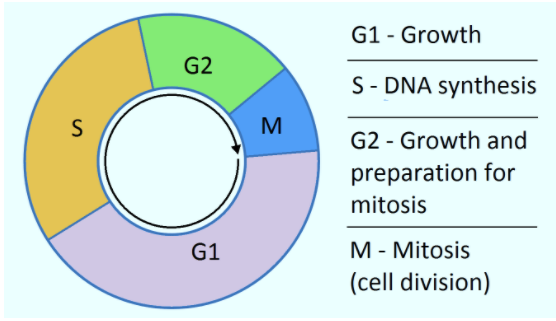
In cell division, a cell plate is formed during
A. Anaphase
B. Metaphase
C. Telophase
D. Cytokinesis
Answer
576k+ views
Hint: Cell plate is the structure found inside the dividing cells of terrestrial plants and some algae.
Cell plate develops in the middle plane of the cell separating two daughter cells during cell division.
Complete answer: The cell cycle has four stages – G1, G2, S, and M phase.
The M phase or mitotic phase has 4 phases - Prophase, Metaphase, Anaphase, and Telophase.
The G1, G2, and S phase together are known as interphase.
Cytokinesis begins in anaphase and ends in telophase, reaching completion as the next interphase begins.
The cytoplasm of the plant cell is partitioned from the inside out by the construction of a new cell wall, called the cell plate, between the two daughter nuclei during cytokinesis.
The orientation of the cell plate determines the positions of the two daughter cells relative to neighboring cells. Altering the planes of cell division, together with the enlargement of the cells by expansion or growth, leads to a different cell and tissue shapes that help determine the form of the plant.

Additional information: The cell plate is formed from vesicles made by dictyosomes and arranged by the microtubules of the phragmoplast in the equatorial region of the spindle. The vesicles contain pectin, cellulose, and hemicellulose, which contribute to the middle lamella and the primary wall of the new cell wall.
So, the answer is D. Cytokinesis
Note: Cytokinesis process entails the delivery of Golgi-derived and endosomal vesicles carrying cell wall and cell membrane components to the plane of cell division and the subsequent fusion of these vesicles within this plate.
Cell plate develops in the middle plane of the cell separating two daughter cells during cell division.
Complete answer: The cell cycle has four stages – G1, G2, S, and M phase.
The M phase or mitotic phase has 4 phases - Prophase, Metaphase, Anaphase, and Telophase.
The G1, G2, and S phase together are known as interphase.
Cytokinesis begins in anaphase and ends in telophase, reaching completion as the next interphase begins.
The cytoplasm of the plant cell is partitioned from the inside out by the construction of a new cell wall, called the cell plate, between the two daughter nuclei during cytokinesis.
The orientation of the cell plate determines the positions of the two daughter cells relative to neighboring cells. Altering the planes of cell division, together with the enlargement of the cells by expansion or growth, leads to a different cell and tissue shapes that help determine the form of the plant.

Additional information: The cell plate is formed from vesicles made by dictyosomes and arranged by the microtubules of the phragmoplast in the equatorial region of the spindle. The vesicles contain pectin, cellulose, and hemicellulose, which contribute to the middle lamella and the primary wall of the new cell wall.
So, the answer is D. Cytokinesis
Note: Cytokinesis process entails the delivery of Golgi-derived and endosomal vesicles carrying cell wall and cell membrane components to the plane of cell division and the subsequent fusion of these vesicles within this plate.
Recently Updated Pages
Master Class 12 Business Studies: Engaging Questions & Answers for Success

Master Class 12 Economics: Engaging Questions & Answers for Success

Master Class 12 English: Engaging Questions & Answers for Success

Master Class 12 Maths: Engaging Questions & Answers for Success

Master Class 12 Social Science: Engaging Questions & Answers for Success

Master Class 12 Chemistry: Engaging Questions & Answers for Success

Trending doubts
Which places in India experience sunrise first and class 9 social science CBSE

Fill the blanks with the suitable prepositions 1 The class 9 english CBSE

Write the 6 fundamental rights of India and explain in detail

Difference Between Plant Cell and Animal Cell

What is the Full Form of ISI and RAW

Golden Revolution is related to AFood production BOil class 9 social science CBSE




